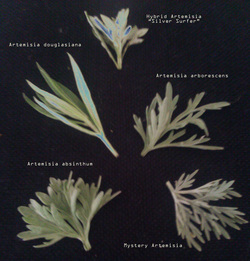|
7/10/2013 7 Comments Power to the Artemisia! The picture is a leaf from all five Artemisias in my garden at the moment. Starting from the bottom left up then up and over, I humbly introduce to you: * Artemisia absinthum - Most well known due to the fact that it is used in the making of the famed spirit, Absinthe. It contains an aromatic ketone called Thujone that IF OVERUSED can be neurotoxic, it is good to note but you would REALLY have to over do it to intake that much. Note: Thujone is also responsible for the PARASITE killing properties of many Artemisias. * Artemisia douglasiana - NATIVE to NORTHERN CALIFORNIA. It contains Matricin which converts upon distillation into Azulene, which is a beautiful deep blue color, and is a well known Anti-inflammatory agent that is now synthesized and widely used. I am in love with this plant right now. * Artemisia ludoviciana + douglasiana + sukdorfii = SILVER SURFER. I distilled it's leaves in the practice still to see if it would be blue but it was not the right time or plant part. The scent was fresh green, herbaceous, and fruity/floral. It is about to flower, perhaps I shall repeat my experiment! * Artemisia arborescens - Jeanne Rose has a huge bush of this in her backyard, and we have distilled it in her distillation classes she teaches in June. It came out a brilliant blue (also due to Azulene) and intensely herbaceous to smell. It has been indicated for use on skin cancers and is a very special potent medicine. This was recently planted and it is expanding already! * Artemisia ?? - This plant was already in the yard when I moved in. The leaves are a different color and thinner than the Artemisia arborescens or the absinthum. Let us know if you know what it is (bottom right of picture). Artemisia ludoviciana var. Nutt is the one I want to grow for distillation, it is native of northern California and the essential oil is more anti-inflammatory then Roman Chamomile!! It can be found currently in our Honey Creme Cleanser, and is often used in treatments and skin detoxes. It is definitely always in my back bar and within close reach at home.
7 Comments
Monkey Boi
12/3/2013 07:26:52 am
The Artemisia on the bottom right looks a lot like Artemisia 'Powis Castle', which I believe is a hybrid of A. absinthium and another Artemisia. It is more popular with landscapers than A. absinthium because it looks pretty all year and is easier to manage. I learned about this hybrid when I bought it a Bay Area nursery that misrepresented it as A. absinthium. A quick analysis on my GC showed that it does also contain thujone and some of the other terpenes found in A. absinthium. My A. pontica seemed to prefer to grow under the Powis rather than the A. absinthium.
Reply
Monkey Boi
12/3/2013 08:54:22 am
Powis Castle is A. arborescens x absinthium
Reply
The Seasonal Apothecary
12/3/2013 04:53:48 pm
Oh the joys of phyto-fornication. Monkey Boi have I told you how much I love and alchemically adore you? Can you please invite me over to play soon.
Reply
The Seasonal Apothecary
12/3/2013 04:55:02 pm
What a great combo, arborescens and absinthum...YES!!
Reply
1/27/2014 12:07:45 am
Our west coast Artemisia absinthium (Wormwood) and Mugwort DO NOT contain thujone and neither does our Artemisia arborescens. That is why California made Absinthe is legal as it is made with west coast Wormwood and thus NO thujone. It is all in the chemistry and the terroir. If you want thujone use Mugwort or Wormwood from Europe.
Reply
Brandon the Herb Guy
3/9/2015 07:37:19 pm
This really confuses me. The production of thujone is genetic, so A. absinthium should always produce thujone in ideal conditions.
Reply
Monkey Boi
3/10/2015 06:30:43 am
All American Absinthe, including St. George absinthe made in California, can contain up to 10 mg/L of thujone and still be considered "thujone-free" under American law. The European Union has exactly the same limit for thujone in absinthe of 10 mg/L. Even most of the historical recipes/samples for absinthe also come under this limit. http://www.mutineermagazine.com/blog/2010/10/is-the-absinthe-that-is-now-legal-in-the-u-s-real-absinthe/
Reply
Leave a Reply. |
Search by typing & pressing enter

 RSS Feed
RSS Feed
